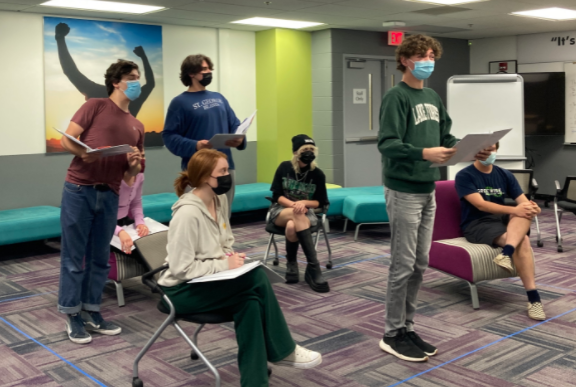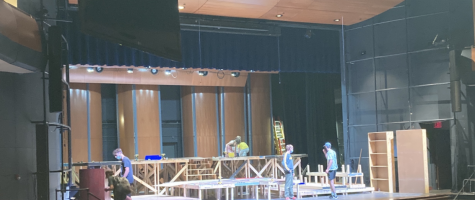And We’re Back: Live Theatre
Theatre gets the chance to perform for an audience after Covid

The cast of the fall show, Clue, during rehearsal
September 24, 2021
The sight of an empty theatre is something that’s sad to visualize. Stage lights off, seats empty, and backstage deserted. It looks wrong, out of place, and dreary. A theatre should be packed with eager audience members as they await to see a show.
That is the backbone of theatre: A live audience.
Ever since the beginning of the Coronavirus pandemic, live theatre has been severely impacted. Even though it is now coming back, things can not be the way they once were.
From remote shows, to live streamed performances, and pre recorded acts, theatre has seen it all. Now that things are starting to look up, the question is: how will live theatre continue?
Things are going to look different for a while, but that is just part of the process. Actors, directors, and tech have all had to deal with their fair share of frustrations throughout the pandemic, and even now, as theatre makes accommodations to get a live audience back.
Even with all of the progress that is being made, the impact that COVID has had on theatre will be everlasting. The amount of dedication that it takes to be a part of live theatre is something that only few can fully comprehend.
Not only is theatre at the high school impacted, but around the world. Just this past week, certain Broadway shows are making their comeback, for the first time since COVID hit. Live audiences are back, and actors, tech, and directors are finally given the chance to do what they love again.
However, the media has not shed light on the people that have put time and effort into keeping the performing arts alive.
Whether it is spending hours editing a video that would typically be a live performance, directing through a Google Meet, or learning to act virtually, each and every person involved in the production has had to adapt to the circumstances.
Everyone learned something, positive or negative, and a thing or two could be taken away from COVID amongst theatre. Not only has the means of production changed since the pandemic, but so have the people. So how have people changed in theatre due to the pandemic?
Junior John Turelli has been an active member of the Theatre Department since his freshman year, participating in a variety of shows including online ones throughout the past year.
“Having an audience and being on stage with people and not on a screen makes all the difference,” Turelli said. “Online theatre has taught me a lot of patience, and taught me to be cognizant when I am back in person of how valuable person to person acting is.”
Not only are actors severely impacted by COVID, but so is tech. They went from building sets and managing lighting, sound, and every cue there is in a show, to editing online performances and taking things digitally.
“WiFi was definitely the biggest challenge. People’s WiFi cut out a lot during recording which was the hardest thing,” junior Vince Boberski said. “Recording something, you have so many chances to get it perfect, whereas live, you only get one chance, so we decided to use all those chances to get everything right.”
Furthermore, directors were also presented with the challenge of learning to put on a show in an online format. Community and ensemble is something that the cast of a show relies heavily on, so being stuck to a screen caused a major roadblock.
“It wasn’t the same,” said theatre director Mr. John Wanninger. “Normally at rehearsal if your scene isn’t on you’re backstage talking with people, bonding with them, making friends with them, laughing with other cast members, but instead you’re just sitting at home by yourself in a room.”

As the director of both the frosh/soph show and the musical and last year, Wanninger got to witness when the students were first able to start to come back in for Spamalot rehearsals, saying it was “one of the best things” to see them all back in the same room.
“It’s very heartening to watch kids be able to interact both on stage and off stage and rebuild that community that somewhat slipped away at the beginning of last year,” Mr. Wanninger said.






